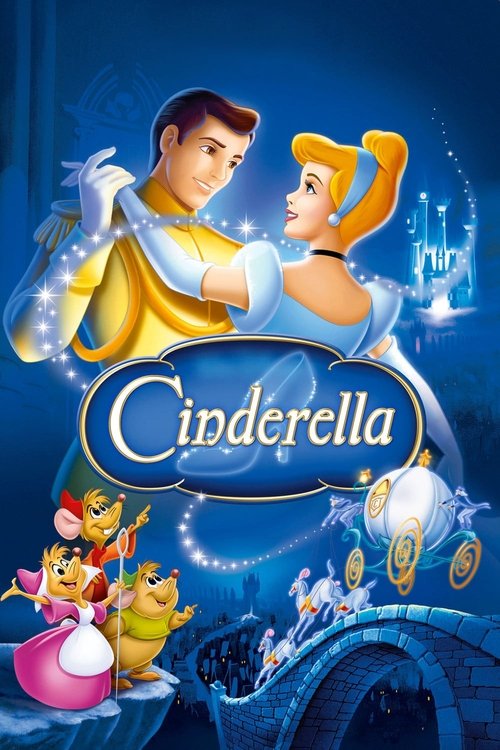
 Cinderella
— The greatest love story ever told.
Cinderella
— The greatest love story ever told.
Cinderella

Cinderella has faith her dreams of a better life will come true. With help from her loyal mice friends and a wave of her Fairy Godmother's wand, Cinderella's rags are magically turned into a glorious gown and off she goes to the Royal Ball. But when the clock strikes midnight, the spell is broken, leaving a single glass slipper... the only key to the ultimate fairy-tale ending!





































If there’s one fairy tale that perfectly captures the classic Disney spirit, it’s “Cinderella.” Released in 1950, the film marked a triumphant comeback for the studio after the tough years of World War II, establishing itself as a landmark in animation and securing the company’s financial survival. But more than just a commercial success, “Cinderella” is a masterclass in cinematic storytelling, striking the perfect balance between emotion, humor, and visual enchantment. It follows a traditional fairy tale structure, sure, but what makes it special is the sheer sophistication of its execution.
The story is simple but effective: Cinderella lives under the rule of her cruel stepmother, Lady Tremaine, and her spoiled stepsisters, Drizella and Anastasia. Despite the daily mistreatment, she remains kind and hopeful, finding comfort in the friendship of the household animals. Meanwhile, on the other side of town, the King wants his son to find a wife, so he throws a royal ball where every eligible young woman in the kingdom must attend. Naturally, Cinderella wants to go, but her family sabotages her. Enter the Fairy Godmother, who turns a night of despair into a magical event that will change Cinderella’s life forever.
The film truly shines in how it builds its protagonist. Contrary to what some might think, Cinderella isn’t a passive character. Within the limits of her reality, she resists in the only way she can—by holding onto her dignity and hope. The scene where her first chance at happiness is brutally taken away—the dress ripped to shreds—is one of the most emotionally devastating moments in classic animation. And this is where Cinderella’s strength really comes through: her journey isn’t just about finding the prince, but about proving that her kindness and resilience are more powerful than the cruelty surrounding her.
Lady Tremaine is a formidable villain. Unlike the witches and sorceresses of other fairy tales, she doesn’t need magic to exert control. Her power comes from psychological manipulation, from the cold, calculated way she crushes any trace of happiness in her stepdaughter’s life. Eleanor Audley voices her with chilling subtlety, making her one of Disney’s most memorable antagonists. Meanwhile, Drizella and Anastasia serve as comic relief, leaning into their arrogance and stupidity while still maintaining a mean streak.
The film’s humor is another one of its biggest strengths. The constant battle between the mice—especially Jaq and Gus—and the cat Lucifer adds an energetic dynamic that balances out the darker parts of the story. These scenes, with a vibe reminiscent of “Tom & Jerry,” work not just as comic relief but also as a way to strengthen Cinderella’s bond with her little allies.
Visually, “Cinderella” is breathtaking. Even with the limitations of the 4:3 format of the time, the film creates a grand sense of scale, whether through the imposing set designs or the fluidity of the animation. The character designs are flawless, with each one standing out visually and personality-wise. The transformation scene, where the Fairy Godmother gives Cinderella her iconic sparkling blue gown, remains one of the most magical moments ever animated—a true testament to the brilliance of Disney’s legendary “Nine Old Men.”
The soundtrack is another standout element. From “A Dream Is a Wish Your Heart Makes” to “Bibbidi-Bobbidi-Boo,” the songs aren’t just incredibly memorable—they play an essential role in shaping the film’s atmosphere. The sweet melodies and hopeful lyrics reinforce the movie’s enchanting tone, while Oliver Wallace’s instrumental score adds both grandeur and tension in all the right moments.
If there’s one thing that could’ve been fleshed out more, it’s the Prince. Much like in “Snow White,” he functions more as a symbol of the happy ending than a fully developed character. His presence in the story is minimal, and a little more interaction between him and Cinderella could have made their romance more engaging. Likewise, the fact that the glass slipper doesn’t turn back to normal after midnight could be seen as a plot convenience—but within the logic of a fairy tale, it’s one of those magical details that just work.
Overall, “Cinderella” isn’t just a well-told fairy tale—it’s a timeless film. Its impact on pop culture is undeniable, inspiring countless adaptations and sequels. But more importantly, its message about hope and perseverance remains just as powerful today. It’s the ultimate proof that sometimes, all you need is a little faith and a touch of magic to turn even the darkest moments into something extraordinary.